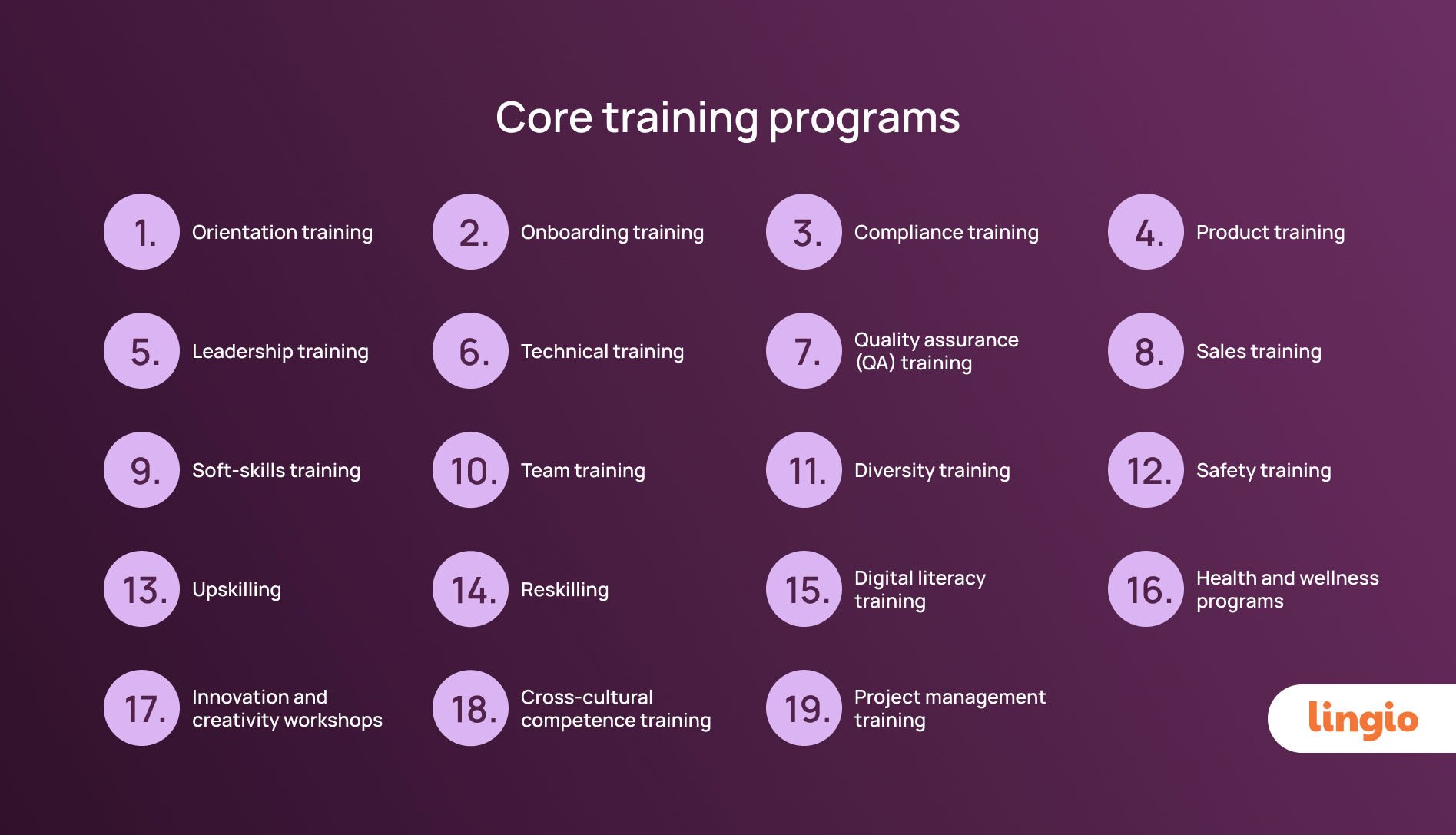Core training programs: The backbone of effective employee development
Core training programs are essential to any organisation’s learning and development strategy. They provide employees with the foundational knowledge and skills to perform their roles effectively. Such programs enhance employee engagement and performance, aligning their capabilities with the organisation’s strategic goals, fostering a productive and engaged workforce.

Here, we’ll explore five key types of core training programs, explaining their importance and providing practical strategies for successful implementation.
1. Orientation training
Orientation training is the first step in building a foundational understanding for new employees. It immerses them in the company’s culture, values, and behavioural expectations. This phase also introduces new hires to essential internal processes, safety protocols, and specific job duties, facilitating a smooth transition into their new workplace environment.
Some successful implementation strategies for orientation training include:
- Develop a welcoming first-day agenda: Organise the first day to include key introductions, a workplace tour, and an overview of the company’s culture and values.
- Create comprehensive resource packs: Equip new employees with resource packs containing manuals, internal system access, contact lists, and other essential training materials to aid their initial navigation.
- Implement interactive sessions: Facilitate engagement through interactive sessions like Q&A with leadership and team-building activities.
- Regular check-ins: Schedule ongoing meetings to address concerns and offer support during their early days.
- Leverage online training modules: Use online training to provide flexible and consistent orientation content that new hires can access at their convenience.
2. Onboarding training
Onboarding training ensures a deeper integration of new hires into the company, extending beyond the initial orientation. This training phase is critical for embedding employees into their specific roles, providing detailed insights into their departmental functions, and aligning their personal goals with the organisation's strategic objectives. It supports the development of necessary skills and knowledge over the first few months, which is essential for long-term success and job satisfaction.
Some successful implementation strategies for onboarding training include:
- Set clear performance milestones: Define and review specific, measurable milestones to track and adjust the progress of new hires during onboarding.
- Tailor role-specific training sessions: Design role-specific training that covers technical skills, operational procedures, and strategic insights.
- Peer buddy system: Pair new employees with a 'buddy' from their team who can guide them through their first few months. This buddy can be a go-to person for any questions and help integrate the new hire into the company's social fabric.
- Facilitate cross-functional team interactions: Organise interactions with various departmental teams to enhance new hires' understanding of the company's operations and promote interdepartmental collaboration.
3. Compliance training
Compliance training is vital for educating employees on the laws, regulations, and company policies that govern their day-to-day work activities. This training ensures that employees understand their legal and ethical obligations, reducing the risk of regulatory violations and promoting a culture of compliance. It covers areas such as data protection, workplace safety, anti-discrimination policies, and industry-specific regulations, which are crucial for maintaining the integrity and legal standing of the organisation.
Some successful implementation strategies for compliance training include:
- Incorporate case studies: Enhance your compliance training program with real-world scenarios to demonstrate practical implications.
- Conduct regular refreshers: Schedule updates and refresher sessions to maintain current knowledge of regulations.
- Use interactive modules: Employ quizzes and simulations to make learning more engaging and memorable.
- Organise legal expert sessions: Incorporate webinars and live Q&A sessions with legal experts to offer current insights and address complex issues directly.
4. Product training
Product training equips employees with detailed knowledge of the company's products or services, which is crucial for those directly involved in selling, supporting, or improving these offerings. This training enables employees to discuss product features confidently, troubleshoot common problems, and provide exceptional customer service. It also ensures that all relevant teams are knowledgeable about product updates and innovations, which is key to maintaining competitive advantage and customer satisfaction.
Some successful implementation strategies for product training include:
- Blend traditional and digital methods: Combine classroom training with digital platforms for flexible and interactive learning.
- Utilise AI and VR for immersive learning: Use AI and VR to simulate real-life product interactions, enhancing practical understanding.
- Implement customer feedback integration: Incorporate customer feedback into training sessions to highlight common issues and demonstrate how products meet user needs, ensuring training remains aligned with market demands.
5. Leadership training
Leadership development training programs are designed to build essential leadership qualities and skills within the organisation’s current and future leaders. These programs focus on strategic thinking, effective communication, and the ability to motivate and guide teams towards achieving business goals. This training helps leaders understand organisational dynamics, change management, and how to create a positive and productive workplace culture. It’s also aimed at building resilience and adaptability in leadership roles, which are crucial for handling the complexities of modern business environments.
Some successful implementation strategies for leadership training include:
- Implement mentorship programs: Pair up-and-coming leaders with experienced executives to provide guidance, share insights, and facilitate personal and professional growth.
- Offer real-world leadership challenges: Incorporate practical leadership challenges that allow trainees to apply their skills in real-world scenarios. This could involve leading project teams, managing crises, or running meetings.
- Enhance coaching skills: Provide training on coaching techniques to enable leaders to develop their teams more effectively, fostering talent and driving organisational performance.
Having a solid set of core training programs helps organisations build a strong foundation for staff training and development. Now, we will transition from these foundational training elements to more specialised approaches to refine specific skill sets essential for personal and professional growth.







